693. Grey Tit-flycatcher (Formerly known as Fantailed Flycatcher) Myioparus plumbeus (Waaiestertvlieevanger)
Order: Passeriformes. Family: Muscicapidae
Description
14 cm. Blue-grey on the back with white underparts. Uppertail is black with white outertail feathers.
Distribution
Occupies patches across sub-Saharan Africa, from Senegal to Ethiopia south to southern Africa. Here it is localised and uncommon, occurring in Mozambique, Zimbabwe, north-eastern South Africa, northern Botswana and the Caprivi Strip (Namibia).
Habitat
Woodland, riverine forests and savanna.
Diet
It mainly eats insects doing most of its foraging in the tree canopy, gleaning prey from leaves and branches.
Breeding
The nest is built by both sexes, consisting of a thin-walled cup built of roots, fine grass, shredded bark and lichens, lined with feathers and flowers. It is typically placed in a cavity in a tree, either natural or made by a woodpecker or barbet. Egg-laying season is from August-January, peaking from October-December. It lays 2-3 dull white eggs, thickly spotted with olive and brown.
Call
The call is a loud, cheerful teee-reee. Listen to Bird Call.
Status
Uncommon resident.
Africa Wild Bird Book
Grey Tit-flycatcher
Dewi
What is the good of having a nice house without a decent planet to put it on? (H D Thoreau)
What is the good of having a nice house without a decent planet to put it on? (H D Thoreau)
Grey Tit-flycatcher Photos
693. Grey Tit-flycatcher Myioparus plumbeus (Waaiestertvlieevanger)
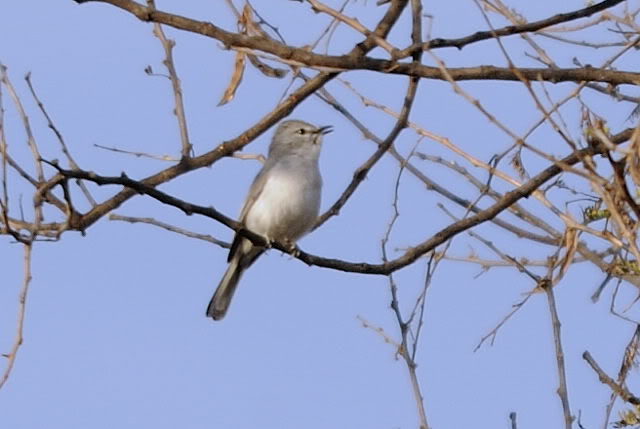
Links:
Species text Sabap1
Sabap2

Links:
Species text Sabap1
Sabap2
Dewi
What is the good of having a nice house without a decent planet to put it on? (H D Thoreau)
What is the good of having a nice house without a decent planet to put it on? (H D Thoreau)
Southern Black Flycatcher
694. Southern Black Flycatcher Melaenornis pammelaina (Swartvlieevanger)
Order: Passeriformes. Family: Muscicapidae
Description
20-22 cm. An all black Flycatcher with dark eyes. In some light appears blueish coloured. Tail is square ended, slightly indented at tip. Outer tail feathers are straight. Flies out from a prominent perch to catch insects in flight.
Similar species: It can be confused with the male Black Cuckooshrike but lacks the yellow gape and has a square (not rounded) tail. Eyes are dark brown in contrast to the red eyes of of in-range Drongos such as Fork-tailed Drongo and Square-tailed Drongo. Square-tailed and Fork-tailed Drongos have very short legs, and tail of latter deeply forked (not square). Head of smaller Square-tailed Drongo is proportionally smaller and more rounded.
Distribution
From Kenya, southern DRC and Tanzania through Angola and Zambia to southern Africa. Here it is common throughout the eastern and northern areas of the region.
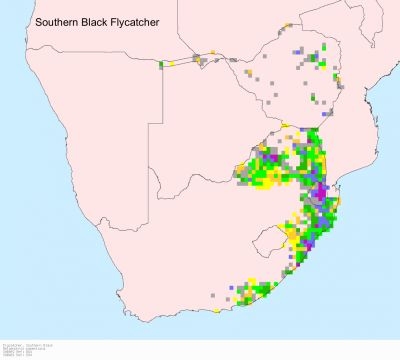
Habitat
Woodland and forest edge, savanna.
Diet
It mainly eats insects, doing most of its foraging from a low perch, such as a fencepost or the outermost, lowest branch of a tree, from which it pounces on prey on the ground and in the air. It may also glean prey from leaves and branches, and it occasionally joins mixed-species foraging flocks, especially with Fork-tailed drongos.
Breeding
The nest is a shallow, thin-walled cup usually built of dry grass and other plant material, on a foundation of twigs, lined with fine rootlets. It is typically placed in a hollow, such as a cavity in a tree trunk left by a falling branch or behind peeling bark of a burnt tree, less commonly in the broken light of an abandoned tractor, creeper tangles, banana bunches and palm sheaths. Egg-laying season is from about May-January, peaking from September-October. It lays 1-4 egg, which are probably incubated by the female for 13-16 days. The chicks are fed by both parents, leaving the nest after about 15-20 days.
Call
High-pitched whistles, often a 3-phrase tseep-tsoo-tsoo.
Listen to Bird Call: http://www.xeno-canto.org/species/Melae ... pammelaina
Status
Common resident.

Order: Passeriformes. Family: Muscicapidae
Description
20-22 cm. An all black Flycatcher with dark eyes. In some light appears blueish coloured. Tail is square ended, slightly indented at tip. Outer tail feathers are straight. Flies out from a prominent perch to catch insects in flight.
Similar species: It can be confused with the male Black Cuckooshrike but lacks the yellow gape and has a square (not rounded) tail. Eyes are dark brown in contrast to the red eyes of of in-range Drongos such as Fork-tailed Drongo and Square-tailed Drongo. Square-tailed and Fork-tailed Drongos have very short legs, and tail of latter deeply forked (not square). Head of smaller Square-tailed Drongo is proportionally smaller and more rounded.
Distribution
From Kenya, southern DRC and Tanzania through Angola and Zambia to southern Africa. Here it is common throughout the eastern and northern areas of the region.

Habitat
Woodland and forest edge, savanna.
Diet
It mainly eats insects, doing most of its foraging from a low perch, such as a fencepost or the outermost, lowest branch of a tree, from which it pounces on prey on the ground and in the air. It may also glean prey from leaves and branches, and it occasionally joins mixed-species foraging flocks, especially with Fork-tailed drongos.
Breeding
The nest is a shallow, thin-walled cup usually built of dry grass and other plant material, on a foundation of twigs, lined with fine rootlets. It is typically placed in a hollow, such as a cavity in a tree trunk left by a falling branch or behind peeling bark of a burnt tree, less commonly in the broken light of an abandoned tractor, creeper tangles, banana bunches and palm sheaths. Egg-laying season is from about May-January, peaking from September-October. It lays 1-4 egg, which are probably incubated by the female for 13-16 days. The chicks are fed by both parents, leaving the nest after about 15-20 days.
Call
High-pitched whistles, often a 3-phrase tseep-tsoo-tsoo.
Listen to Bird Call: http://www.xeno-canto.org/species/Melae ... pammelaina
Status
Common resident.

Dewi
What is the good of having a nice house without a decent planet to put it on? (H D Thoreau)
What is the good of having a nice house without a decent planet to put it on? (H D Thoreau)
Southern Black Flycatcher Photos
694. Southern Black Flycatcher Melaenornis pammelaina (Swartvlieevanger)
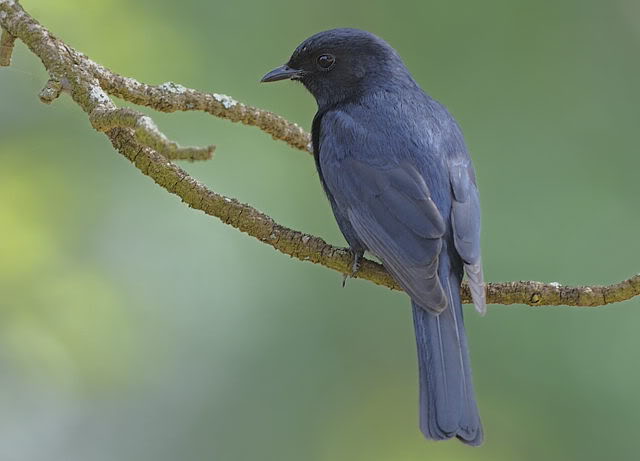

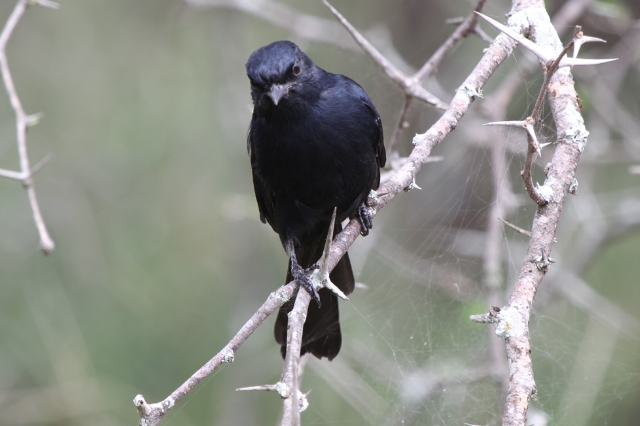 © Tina
© Tina
Kruger National Park, Lake Panic road
 © Dewi
© Dewi
Kruger National Park, S86
 © Flutterby
© Flutterby
Links:
Species text Sabap1
Sabap2


 © Tina
© TinaKruger National Park, Lake Panic road
 © Dewi
© DewiKruger National Park, S86
 © Flutterby
© FlutterbyLinks:
Species text Sabap1
Sabap2
Dewi
What is the good of having a nice house without a decent planet to put it on? (H D Thoreau)
What is the good of having a nice house without a decent planet to put it on? (H D Thoreau)
Pale Flycatcher
696. Pale Flycatcher Melaenornis pallidus (Muiskleurvlieevanger)
Order: Passeriformes. Family: Muscicapidae
Description
17 cm. A medium-sized flycatcher with a slender bill, a drab plumage and long but rounded wings. Back is greyish brown with buff underparts and paler throat.
Distribution
From Ethiopia and Sudan through Tanzania, Angola and Zambia to southern Africa. Here it is fairly common in Zimbabwe, Mozambique, north-eastern South Africa, northern Botswana and Namibia.
Habitat
Broad-leaved woodland.
Diet It mainly eats insects, doing most of its foraging from a low perch, from which it pounces on prey on the ground. It may also join mixed-species foraging flocks, gleaning prey from leaves and branches and occasionally hawking insects aerially.
Breeding
The nest is built by the female in about a week, consisting of a cup which is usually built of long, dark stems of weeds with flower tops, grass, lichen and dead leaves, usually lined with fine rootlets and feathers. It is typically placed in between a few twigs in the uppermost branches of a smaller tree surrounded by larger trees, usually around 2-3 m above ground. Egg-laying season is from August-January, peaking from about September-November. The female lays 2-4 eggs, which are incubated solely by the female for about 14 days, occasionally taking a break to go and forage. The chicks are fed by both adults and are brooded the first five days of their lives, eventually leaving the nest at about 17 days old.
Call
High-pitched warble of raspy notes. Listen to Bird Call.
Status
Uncommon resident.
Order: Passeriformes. Family: Muscicapidae
Description
17 cm. A medium-sized flycatcher with a slender bill, a drab plumage and long but rounded wings. Back is greyish brown with buff underparts and paler throat.
Distribution
From Ethiopia and Sudan through Tanzania, Angola and Zambia to southern Africa. Here it is fairly common in Zimbabwe, Mozambique, north-eastern South Africa, northern Botswana and Namibia.
Habitat
Broad-leaved woodland.
Diet It mainly eats insects, doing most of its foraging from a low perch, from which it pounces on prey on the ground. It may also join mixed-species foraging flocks, gleaning prey from leaves and branches and occasionally hawking insects aerially.
Breeding
The nest is built by the female in about a week, consisting of a cup which is usually built of long, dark stems of weeds with flower tops, grass, lichen and dead leaves, usually lined with fine rootlets and feathers. It is typically placed in between a few twigs in the uppermost branches of a smaller tree surrounded by larger trees, usually around 2-3 m above ground. Egg-laying season is from August-January, peaking from about September-November. The female lays 2-4 eggs, which are incubated solely by the female for about 14 days, occasionally taking a break to go and forage. The chicks are fed by both adults and are brooded the first five days of their lives, eventually leaving the nest at about 17 days old.
Call
High-pitched warble of raspy notes. Listen to Bird Call.
Status
Uncommon resident.
Dewi
What is the good of having a nice house without a decent planet to put it on? (H D Thoreau)
What is the good of having a nice house without a decent planet to put it on? (H D Thoreau)
Pale Flycatcher Photos
Dewi
What is the good of having a nice house without a decent planet to put it on? (H D Thoreau)
What is the good of having a nice house without a decent planet to put it on? (H D Thoreau)
-
Michele Nel
- Posts: 1994
- Joined: Mon Sep 10, 2012 10:19 am
- Country: South Africa
- Location: Cape Town
- Contact:
Chat Flycatcher
697. Chat Flycatcher Melaenornis infuscatus (Grootvlieevanger)
Order: Passeriformes. Family: Muscicapidae
Description
15 cm. A large Flycatcher about the size of a Thrush. It is uniformly brownish above and paler underneath and has a plain brown panel on the folded secondaries.
Juvenile is spotted with buff above and below.
Similar species: Very similar to Pale Flycatcher but larger, pale wing edges more prominent. Their ranges are mutually exclusive.
Distribution
Near-endemic to southern Africa, occurring from southern Angola through Namibia (Common in north central and north-eastern Namibia including Kaudom Park, Tsumkwe, Kwando River, Chobe River/Linyati Swamp regions and Bwabwata National Park.) and Botswana to South Africa.
Habitat
It is most common in arid Acacia savanna and Nama Karoo, as well as dry Karoo shrublands and sparse dry woodland or dry fynbos.
Diet
It mainly eats insects, doing most of its foraging from a low perch, pouncing on prey on the ground.
Breeding
The nest is a bulky, untidy bowl built of dry plant stems, twigs and coarse grass lined with finer material such as rootlets and plant down. Aromatic plants, such as cudweed (Gnaphalium) and everlastings (Helichyrsum), are often used in nest construction, probably because they repel insects. It is typically placed in a low bush which sometimes, but not always, conceals the nest from predators. Egg-laying season is basically year-round, and is thought to coincide with rainfall, but it probably peaks around September-March. It lays 2-3 eggs, which are incubated solely by the female for about 14-15 days, while the male feeds her at the nest. The chicks are brooded for parts of their early lives and are fed by both parents, eventually leaving the nest after about 11-14 days.
Call
Song a rich, warbled cher-cher-cherrip, with squeaky, hissing notes.
Order: Passeriformes. Family: Muscicapidae
Description
15 cm. A large Flycatcher about the size of a Thrush. It is uniformly brownish above and paler underneath and has a plain brown panel on the folded secondaries.
Juvenile is spotted with buff above and below.
Similar species: Very similar to Pale Flycatcher but larger, pale wing edges more prominent. Their ranges are mutually exclusive.
Distribution
Near-endemic to southern Africa, occurring from southern Angola through Namibia (Common in north central and north-eastern Namibia including Kaudom Park, Tsumkwe, Kwando River, Chobe River/Linyati Swamp regions and Bwabwata National Park.) and Botswana to South Africa.
Habitat
It is most common in arid Acacia savanna and Nama Karoo, as well as dry Karoo shrublands and sparse dry woodland or dry fynbos.
Diet
It mainly eats insects, doing most of its foraging from a low perch, pouncing on prey on the ground.
Breeding
The nest is a bulky, untidy bowl built of dry plant stems, twigs and coarse grass lined with finer material such as rootlets and plant down. Aromatic plants, such as cudweed (Gnaphalium) and everlastings (Helichyrsum), are often used in nest construction, probably because they repel insects. It is typically placed in a low bush which sometimes, but not always, conceals the nest from predators. Egg-laying season is basically year-round, and is thought to coincide with rainfall, but it probably peaks around September-March. It lays 2-3 eggs, which are incubated solely by the female for about 14-15 days, while the male feeds her at the nest. The chicks are brooded for parts of their early lives and are fed by both parents, eventually leaving the nest after about 11-14 days.
Call
Song a rich, warbled cher-cher-cherrip, with squeaky, hissing notes.
-
Michele Nel
- Posts: 1994
- Joined: Mon Sep 10, 2012 10:19 am
- Country: South Africa
- Location: Cape Town
- Contact:
Chat Flycatcher Photos
697. Chat Flycatcher Melaenornis infuscatus
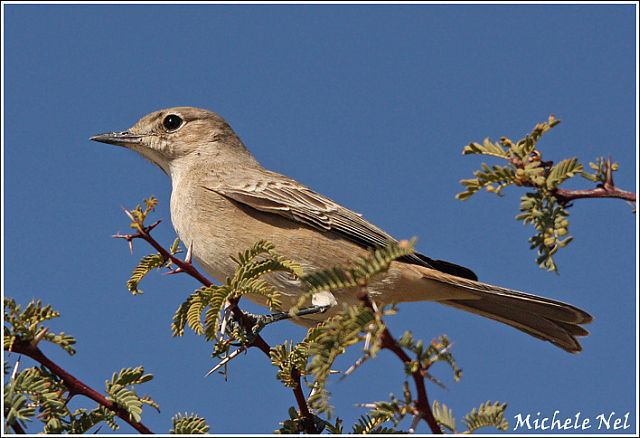 © Michele Nel
© Michele Nel
 © nan
© nan
 © nan
© nan
Kgalagadi Transfrontier Park
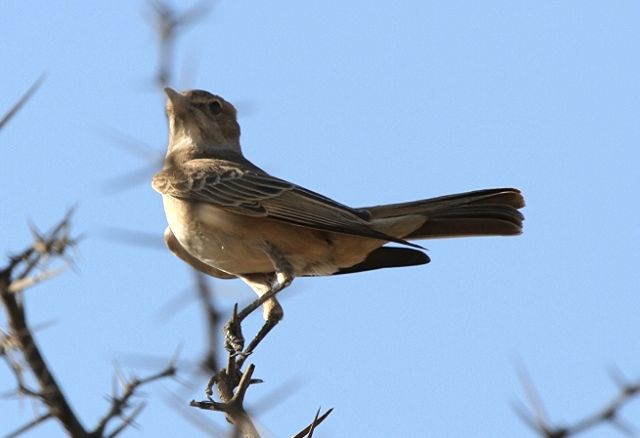 © Tina
© Tina
Kgalagadi Transfrontier Park
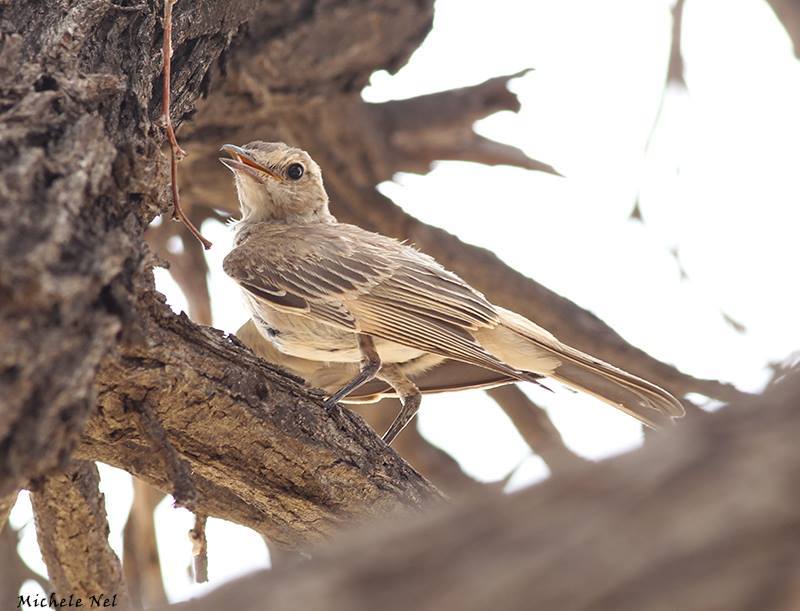
Kgalagadi Transfrontier Park, Polentswa - Jan 2016 © Michele Nel
Links:
Species text Sabap1
Sabap2
Biodiversity Explorer: http://www.biodiversityexplorer.org/bir ... scatus.htm
Habitat Selection by Marico Flycatchers and Chat Flycatchers in the Kalahari Gemsbok National Park
 © Michele Nel
© Michele Nel © nan
© nan © nan
© nanKgalagadi Transfrontier Park
 © Tina
© TinaKgalagadi Transfrontier Park

Kgalagadi Transfrontier Park, Polentswa - Jan 2016 © Michele Nel
Links:
Species text Sabap1
Sabap2
Biodiversity Explorer: http://www.biodiversityexplorer.org/bir ... scatus.htm
Habitat Selection by Marico Flycatchers and Chat Flycatchers in the Kalahari Gemsbok National Park
- Flutterby
- Posts: 44029
- Joined: Sat May 19, 2012 12:28 pm
- Country: South Africa
- Location: Gauteng, South Africa
- Contact:
Marico Flycatcher
695. Marico Flycatcher Melaenornis mariquensis (Maricovlieevanger)
Order: Passeriformes. Family: Muscicapidae
Description
Contrasting pure white underparts and brown upperparts. At close range a buffish ring around the eye and a buff panel in the wings are discernible. Perches conspicuously on leafless outer branches of thorn trees.
Sexes are alike and juveniles are spotted above and streaked below.
Similar species: Differs from similar flycatchers in white underparts contrasting strongly with brown upperparts. This species and the Pale Flycatcher are approximately the same size, but the Marico Flycatcher is white, not mousy-brown, below with uniform brown upperparts.
Distribution
Near-endemic to southern Africa (southern Angola, Zambia, Namibia, Botswana, northern South Africa and southern Mozambique)
The Marico Flycatcher is a specialist of the Acacia thornbelt in the Kalahari basin and adjacent hardveld. It occurs in the northern Cape Province, the northwestern Transvaal, southwestern and central Zimbabwe, over most of Botswana, and northern and central Namibia (except the coastal deserts).
It is abundant in the Kalahari basin, particularly the race acaciae in the southern and western Kalahari. The nominate subspecies is abundant in the arid woodland biome in the upper Limpopo catchment along the Botswana–Transvaal border.
Habitat
Most common in Acacia savanna but also in mixed woodland and Mopane. Often perches along roadsides. It is a specialist of Acacia bushveld and woodland with strongholds in the three Kalahari biomes. Associations with predominantly broadleaved Miombo, Okavango, Mopane and Moist Woodland biomes result from the extensive occurrence of an Acacia mosaic within these biomes.
Diet
Insects, especially termites, caterpillars and grasshoppers.
Breeding
Monogamous. But sometimes the breeding pair is assisted by other adult helpers. It builds small flimsy cup nest of grass and weed stems and lined with rootlets and feathers. It is typically placed between forked twigs of a thorny tree. Egg-laying season is year-round, peaking around October-November, although in Namibia it peaks later, in March. It lays 2-3, rarely 4 eggs, incubated by females only. The chicks are brooded and fed by both parents, leaving the nest after about 14 days.
Occasional host of Diderick Cuckoo.
Call
Series of monotonous harsh unmusical chirps, somewhat sparrow-like tsii-cheruk-tukk.
Status
Common near-endemic, mostly resident with some easterly movements during winter. Usually in pairs or small family parties.
Order: Passeriformes. Family: Muscicapidae
Description
Contrasting pure white underparts and brown upperparts. At close range a buffish ring around the eye and a buff panel in the wings are discernible. Perches conspicuously on leafless outer branches of thorn trees.
Sexes are alike and juveniles are spotted above and streaked below.
Similar species: Differs from similar flycatchers in white underparts contrasting strongly with brown upperparts. This species and the Pale Flycatcher are approximately the same size, but the Marico Flycatcher is white, not mousy-brown, below with uniform brown upperparts.
Distribution
Near-endemic to southern Africa (southern Angola, Zambia, Namibia, Botswana, northern South Africa and southern Mozambique)
The Marico Flycatcher is a specialist of the Acacia thornbelt in the Kalahari basin and adjacent hardveld. It occurs in the northern Cape Province, the northwestern Transvaal, southwestern and central Zimbabwe, over most of Botswana, and northern and central Namibia (except the coastal deserts).
It is abundant in the Kalahari basin, particularly the race acaciae in the southern and western Kalahari. The nominate subspecies is abundant in the arid woodland biome in the upper Limpopo catchment along the Botswana–Transvaal border.
Habitat
Most common in Acacia savanna but also in mixed woodland and Mopane. Often perches along roadsides. It is a specialist of Acacia bushveld and woodland with strongholds in the three Kalahari biomes. Associations with predominantly broadleaved Miombo, Okavango, Mopane and Moist Woodland biomes result from the extensive occurrence of an Acacia mosaic within these biomes.
Diet
Insects, especially termites, caterpillars and grasshoppers.
Breeding
Monogamous. But sometimes the breeding pair is assisted by other adult helpers. It builds small flimsy cup nest of grass and weed stems and lined with rootlets and feathers. It is typically placed between forked twigs of a thorny tree. Egg-laying season is year-round, peaking around October-November, although in Namibia it peaks later, in March. It lays 2-3, rarely 4 eggs, incubated by females only. The chicks are brooded and fed by both parents, leaving the nest after about 14 days.
Occasional host of Diderick Cuckoo.
Call
Series of monotonous harsh unmusical chirps, somewhat sparrow-like tsii-cheruk-tukk.
Status
Common near-endemic, mostly resident with some easterly movements during winter. Usually in pairs or small family parties.
- Flutterby
- Posts: 44029
- Joined: Sat May 19, 2012 12:28 pm
- Country: South Africa
- Location: Gauteng, South Africa
- Contact:
Marico Flycatcher Photos
695. Marico Flycatcher Melaenornis mariquensis
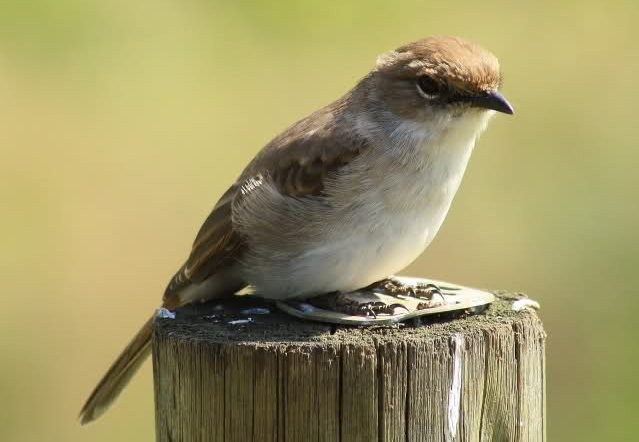 © Flutterby
© Flutterby
 © Mel
© Mel
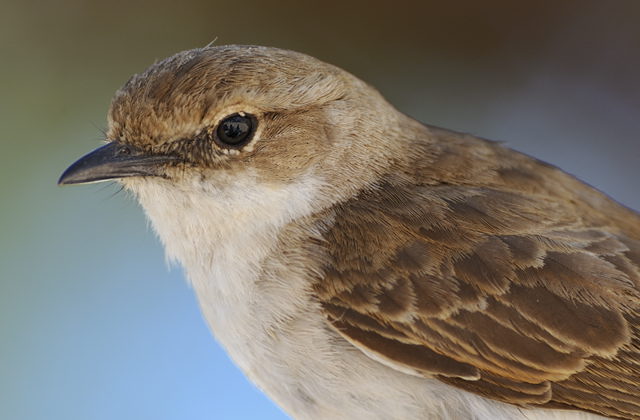 © Dewi
© Dewi
 © BluTuna
© BluTuna
Links:
Species text Sabap1
Sabap2
 © Flutterby
© Flutterby © Mel
© Mel © Dewi
© Dewi © BluTuna
© BluTunaLinks:
Species text Sabap1
Sabap2



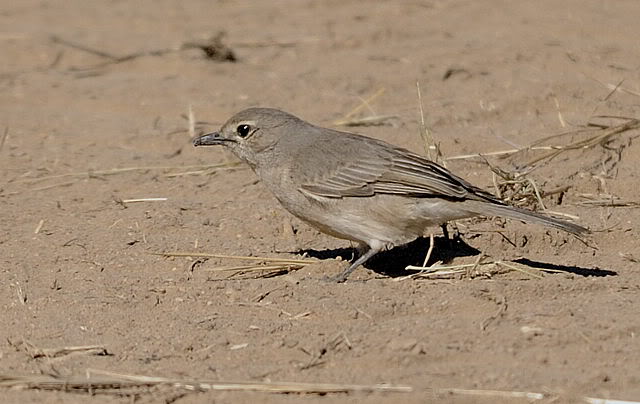
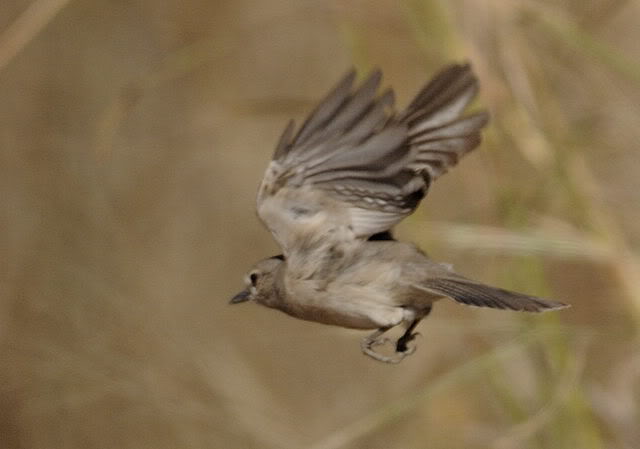 © Dewi
© Dewi